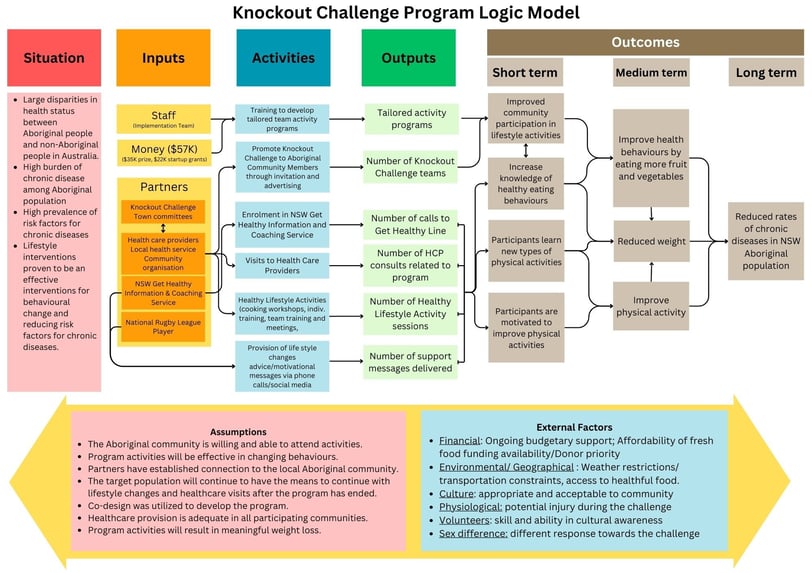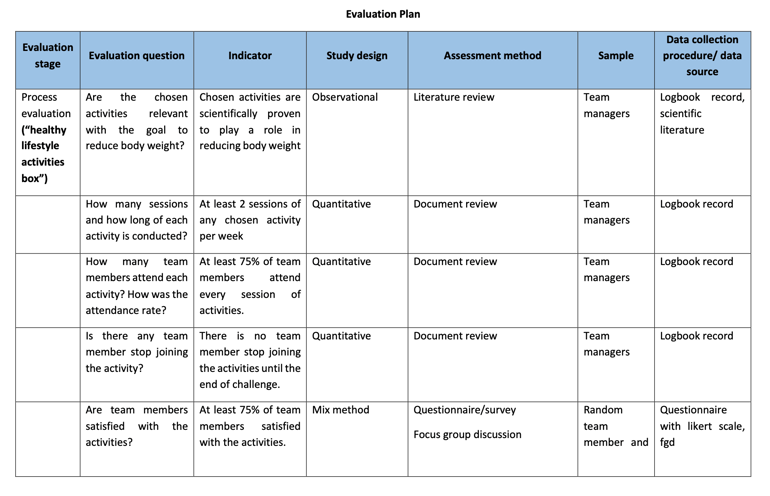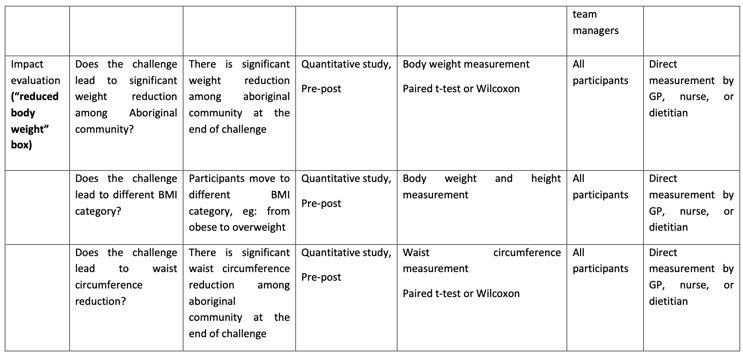Developing a Logic Model and Evaluation Plan
Based on: Passmore, E., Shepherd, B., Milat, A. et al. The impact of a community-led program promoting weight loss and healthy living in Aboriginal communities: the New South Wales Knockout Health Challenge. BMC Public Health 17, 951 (2017). https://doi.org/10.1186/s12889-017-4955-7
REAL WORLD PUBLIC HEALTH PROGRAM EVALUATION
3/20/20243 min read


This Logic Model was developed by Ulfa Ratriana, Rheannon Robyn, Matthew Kyaw, and Anna




So, I choose the box “healthy lifestyle activities” and “reduced body weight”. I believe both are evaluation priorities as those at the heart of the challenge. Each team needs to develop their own healthy lifestyle activities that will help them to succeed in the challenge, that is reducing body weight. Therefore, it is important to evaluate the activities they’ve developed and the results after doing the activities.
To evaluate healthy lifestyle activities, first, we need to make sure that the activities chosen by the team are scientifically proven to contribute to reducing body weight. Therefore, we need to do a literature review. Second, as part of process evaluation, we need to know how many sessions and how long each session is conducted to ensure they keep going with the challenge as a team. For that, a logbook will be given to team managers. They need to record the activities they are doing with the team, so the evaluator team can take a look at it monthly (every 4 weeks). With the logbook, team managers will also need to fill out an attendance check, so evaluators can monitor the attendance rate of each session and if any team members stop joining the activities. It is also important to evaluate participants’ satisfaction. For that, we can do a simple survey by using a questionnaire with a likert scale to get a broad understanding of their satisfaction towards the challenge. Stratified random sampling can be conducted to ensure that samples come from every team. To get a deeper understanding of the satisfaction, focus group discussions with team managers can be conducted. The topic of the discussion can be shared prior to the discussion so team managers can have internal discussions with their team members as well. It will ensure that all participants can voice their opinions about the program.
To evaluate the body weight reduction, we will conduct body weight measurements at the baseline and right after finishing the challenge. It will be done by a health professional, either GP, nurse, or dietitian in health care services. Data can be analysed by using paired sample t-test, if data are normally distributed, or Wilcoxon, if data are not normally distributed, to see if there is any significant body weight reduction (Scheff, 2016). By combining body weight and height data, we can conduct deeper analysis to see if the move towards different BMI categories, for example from obese 2 to obese 1 or obese 1 to overweight. Waist circumference as an indicator of abdominal obesity will also be evaluated (Harvard T.H. Chan School of Public Health, 2012). Waist circumference is expected to be reduced as there is body weight reduction.
Reference:
Harvard T.H. Chan School of Public Health. (2012, October 21). Waist Size Matters. Obesity Prevention Source. https://www.hsph.harvard.edu/obesity-prevention-source/obesity-definition/abdominal-obesity/
Patel, S., Dasu, R., & Kumar, J. (2018). EVALUATION PLAN TEMPLATE FOR LOCAL ORAL HEALTH PROGRAMS. https://oralhealthsupport.ucsf.edu/sites/g/files/tkssra861/f/wysiwyg/Evaluation%20Plan%20Template%20for%20LOHPs.pdf
Scheff, S. W. (2016). Nonparametric Statistics. Fundamental Statistical Principles for the Neurobiologist, 157–182. https://doi.org/10.1016/b978-0-12-804753-8.00008-7
This evaluation plan was developed by Ulfa Ratriana
